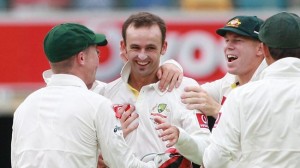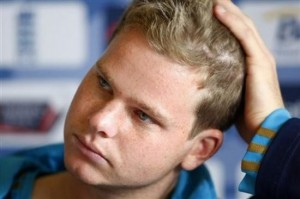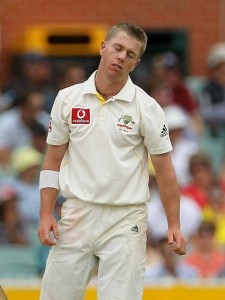
A gradual but inevitable descent into cricket-based loathing and bile.
Would The Real New Shane Warne Please Stand Up?
On the eve of the Perth Test, Nathan Lyon’s position within the Australian squad has come under serious scrutiny for the first time. It would not be surprising to see Lyon dropped and the Australians attempt to exploit the bouncy WACA pitch with four quicks, an approach that provided their only Test victory against England last summer. The Indian batsmen have handled Lyon with ease thus far, as his series average of 90 indicates. More than this, however, his introduction into the attack has often served to relieve the pressure on the Indian batsmen, providing a much needed respite from the barrage delivered by the Aussie quicks. Even the Indian tail has treated Lyon with something bordering on contempt.
With twenty-four wickets from his first nine Tests, Lyon is clearly the incumbent for the time being. But his lack of penetration against an otherwise out of form Indian lineup presents an opportunity to explore Australia’s spinning options, two years out from back-to-back Ashes series.
Nathan Lyon: First Class bowling average 37 (42 wickets)
Lyon’s rise to the international stage has been remarkable. He made his first class debut in February 2011 and by July was taking the wicket of Kumar Sangakkara with his very first Test delivery. An offspinner who is not afraid to give the ball flight, Lyon also possesses remarkable control for someone with such limited first class experience. Such was Lyon’s rapid ascent, the recent Test matches in Brisbane and Sydney represented the first time he had bowled on either ground at any level.
The issue that is now making itself apparent however is his limited repertoire. His stock ball may be strong but he lacks the subtly and variety required to truly unsettleworld-class batsmen determined to build an innings. The question is whether the Australian selectors are prepared to persevere with Lyon in the hope he further develops his game whilst competing against the worlds best, or whether he would be better served spending more time learning his trade in the Sheffield Shield.
Stephen O’Keefe: First Class bowling average 24 (52 wickets)
Lyon’s meteoric rise has largely occurred at the expense of O’Keefe. Having developed his game at home on the spin friendly SCG pitch, the 27 year old left armer earned a call-up to Australia’s Test squad for the series against Pakistan in England last year after a string of strong performances for both NSW and Australia A. Although he was kept out of the team on that occasion by Steve Smith the future looked bright for O’Keefe.
Lyon’s ascendency and a finger webbing injury in November has stalled O’Keefe’s progress and the interruption created by the Big Bash competition means he has been unable to create pressure on Lyon’s position during the Indian tour. O’Keefe will be hoping for a strong second half of the domestic season to press his claims for a position in the squad that will tour the West Indies in March.
Steve Smith: First-class bowling average 46 (41 wickets)
Steve Smith is primarily a batsman who can bowl a little, as his first-class average suggests, rather than the specialist spinner that Australian cricket requires. His batting and athletic fielding means he will be a part of Australian limited overs squads for years to come, but his bowling simply lacks the level of control required to take wickets at Test level.
At only 22 years of age Smith has time to develop his bowling further but with NSW hardly lacking for spinners, with both O’Keefe and Hauritz on their books, Smith‘s bowling opportunities may be limited. As such, Smith is not likely to play another Test any time soon, a revelation that may be viewed with more than a little chagrin by some authors on this site.
Michael Beer: First-class bowling average 45 (46 wickets)
After making his Test debut in the fifth Ashes Test last year, Beer has since slipped back into obscurity. It would be a little unfair to say deservedly so, since despite not troubling the tourists on that occasion, Beer at least showed he possesses the sort of prodigious turn and control that suggests he may have a future in Test cricket.
Beer’s home ground of the WACA, however, is not a friendly haunt for spinners, particularly those still learning their trade. It remains to be seen whether Beer will fulfil his undoubted promise and develop his game further so as to become a genuine Test prospect, or instead focus on those skills more applicable to the shorter forms of the game.
Jason Krejza: First-class bowling average 47 (103 wickets)
After taking eight wickets on his Test debut against India in late 2008, Krejza was forced to pay the price for his inability to spin Australia to victory against the South Africans on a fifth day WACA pitch a little over a month later. Always keen to flight the ball above the batsman’s eye line and capable of achieving steep turn, his bowling lacks the control to effectively build and maintain pressure, a flaw that was brutally exposed on the Test stage.
Krejza remains a part of Australia’s international plans, as his selection in last years World Cup squad proves but appears to be developing into a spinning all-rounder better suited to the shorter form of the game, rather than a specialist spinner. Will probably find his future international prospects limited owing to competition from Steve Smith.
Nathan Hauritz: First-class bowling average 42 (161 wickets)
Hauritz being dropped on the eve of the first Ashes Test to make way for the unproven Xavier Doherty must rank as one of the more bizarre, and in hindsight misguided, selection choices of recent times. Selection dramas are hardly new for Hauritz; he made many of his international appearances for Australia whilst being unable to secure a position within the NSW lineup.
Having recently recovered from a heel injury that has ruled him out of most of this season Hauritz must be determined to force his way back into national team contention. Yet even with a new selection committee in place it seems unlikely that he will feature again in the longer form of the game.
Xavier Doherty: First-class bowling average 44 (117 wickets)
The player who sensationally replaced Hauritz only lasted two Ashes Tests before his lack of variety and penetration was painfully exposed. In many ways Doherty is representative of the new breed of Australian spin bowlers, brought up on a steady diet of limited overs cricket believing that the dot-ball is king.
Doherty has achieved a considerable amount of success, particularly in T20 cricket, by not spinning the ball at all but rather by firing in a series of over and underspun deliveries at the batsman’s pads. Doherty’s ability to tie up one end lead to his elevation to the Australian Test squad but his inability to take wickets led to his exclusion shortly thereafter. His abortive Test career serves as a clear reminder of the unique requirements the longer form of the game demands.
Conclusion
Australia’s spinning stocks have not been at this low a level for many years, which explains in part the genuine delight that greeted Lyon’s successful entry onto the Test stage. The predicted flood of legspinners imitating Shane Warne never materialised and instead many of the new breed focus on quick fingerspin aimed at choking run-rates rather than the more traditional (for Antipodean bowlers at least) wristspin. The impressive performances of Warne, MacGill and Hogg in the Big Bash in part attest to the fact the spin bowlers do not rapidly lose their skills with age, but also that batsmen in Australia’s domestic competition are starved of experience against genuine wristspin bowling.
Lyon will clearly play at his home ground in Adelaide in the fourth test, the ground where he was serving his apprenticeship as a groundkeeper before his meteoric elevation to the international stage. The current absence of any domestic First Class cricket (owing to the intrusion of the Big Bash competition) will ensure Lyon’s retention but his continued selection beyond this series is less certain. Michael Clarke appeared hesitant to use Lyon in the SCG Test, suggesting he is less than completely convinced by his abilities.
Lyon’s performance in the West Indies in March and April will therefore be closely scrutinised, with Stephen O’Keefe appearing to be the most likely candidate to step up if his recent uninspiring form continues. However time still remains for another unknown candidate to force themselves into contention ahead of the 2013 Ashes series. Five years on from Shane Warne’s last Test the spinning situation is as confused as it ever was. Which will no doubt please and amuse Australia’s fiercest rivals.




1 Comment
Post a Comment
1
51allout » Whatever Happened To The Unlikely Lads (International Edition)? #21: Bryce McGain
05 Nov 2012 10:02
[…] a tendency in recent years for the Australian selectors to try to look into fields afar for the next Shane Warne. Disenchanted with the filth merchants stinking up domestic cricket, they seem to think instead […]